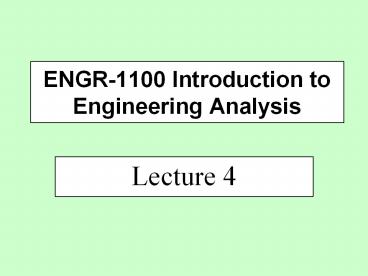ENGR-1100 Introduction to Engineering Analysis - PowerPoint PPT Presentation
1 / 20
Title:
ENGR-1100 Introduction to Engineering Analysis
Description:
The mass of the body can be assumed to be concentrated at a point and the shape ... Make a decision regarding what body is to be isolated and analyzed. ... – PowerPoint PPT presentation
Number of Views:242
Avg rating:3.0/5.0
Title: ENGR-1100 Introduction to Engineering Analysis
1
ENGR-1100 Introduction to Engineering Analysis
- Lecture 4
2
Lecture Outline
- Free body diagram.
- Equilibrium of a particle - two dimensional
problems.
3
A Particle
- Large bodies or small bodies can be referred to
as particles when the size and shape of the body
have no effect on the response of the body to a
system of forces. - The mass of the body can be assumed to be
concentrated at a point and the shape can be
neglected. - A necessary and sufficient condition for
equilibrium - RSF0
- Where SF is the sum of all forces acting on a
particle.
4
Free Body Diagram
- A carefully prepared drawing that shows a body
of interest separated from all interacting
bodies. - The forces exerted by all other bodies must be
determined and shown on the diagram.
5
The procedure for drawing free-body diagram
Essential Steps
- Make a decision regarding what body is to be
isolated and analyzed. - Prepare a sketch of the external boundary of the
selected body. - Present all forces, known and unknown, that are
applied by other bodies with vectors in the
correct position.
6
What should be the body of interest of the
following problem?
7
How to deal with unknown forces?
- If a force has a known line of action but unknown
magnitude and direction, the direction of the
force can be assumed. - If both magnitude and direction of the force are
unknown it might be convenient to show the two
rectangular components of the force.
8
Procedure to construct a complete and correct
free-body diagram
- 1) Decide which body or combination of bodies is
to be shown on the free-body diagram. - 2) Prepare a drawing of the outline of the
free-body. - 3) Carefully trace around the boundary of the
free body and identify all the forces exerted by
contacting or attracting bodies that were removed
during the isolation process. - 4) Choose the set of coordinate axes to be used
in solving the problem and indicate their
direction on the free-body diagram.
9
Equilibrium of a Particle Two Dimensions
R Rx Ry Rn Rt Rxi Ryj Rnen
Rtet SFxi SFyj SFnen SFtet 0
The equation can only be satisfied if
Rx RxiSFxi0 Ry RyjSFyj0 Rn
RnenSFnen0 Rt RtetSFtet0
or
10
Example P3-4
A homogeneous cylinder with mass of 250 kg is
supported against a smooth surface by a cable as
shown in Fig. 3-4. Determine the forces exerted
on the cylinder by the cable and by the smooth
surface at contact point C.
11
Solution
1) Free body diagram
12
1) Equilibrium equations
a
How many unknowns? How many equations?
2
2
SFx0
FCB-FAB sin(a)0
SFy0
FAB cos(a)-2509.80
FAB 2509.8/cos(a) 2525.4 N
13
Class Assignment Exercise set 3-3 please submit
to TA at the end of the lecture
A homogeneous cylinder weighing 500 lb rests
against two smooth planes that form a trough as
shown in Fig. P3-3. Determine the forces exerted
on the cylinder by the plane at contact A and B.
14
Solution
1) Free body diagram
a) Choose the body
b) Prepare the drawing
d) Choose coordinate axes
15
1) Equilibrium equations
How many unknowns? How many equations?
SFx0
FA-FB sin(300)0
SFy0
FB cos(300)-5000
FB 500/cos(300) 577.4 lb
16
Example P3-17
A continuous cable is used to support blocks A
and B as shown in Fig. P3-17. Block A is
supported by a small wheel that is free to roll
on the cable. Determine the displacement y of
block A for equilibrium if the weight of block A
and B are 50 lb and 75 lb, respectively.
17
Solution
1) Free body diagram body B
T
y
75 lb
SFy0
T -750
18
1) Free body diagram body A
How many unknowns? How many equations?
Two a and b Two SFx0, SFy0
19
SFx0
T cos(a) - T cos(b) 0
SFy0
T sin(a)T sin(a) - 500
sin(a) 50/150
a 19.50
y10/2tan(19.50)1.77 ft
20
Class Assignment Exercise set 3-13 please submit
to TA at the end of the lecture
Two flower pots are supported with cables as
shown in Fig. P13-3. If pot A weighs 10 lb and
pot B weighs 8 lb, determine the tension of the
cables and the slope of cable BC.
Answer TABTCD12.73 lb a6.340 TBC9.06 lb
B
A































